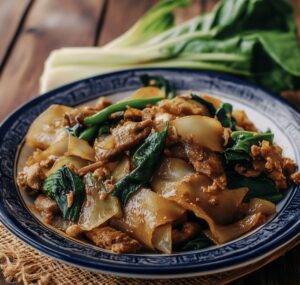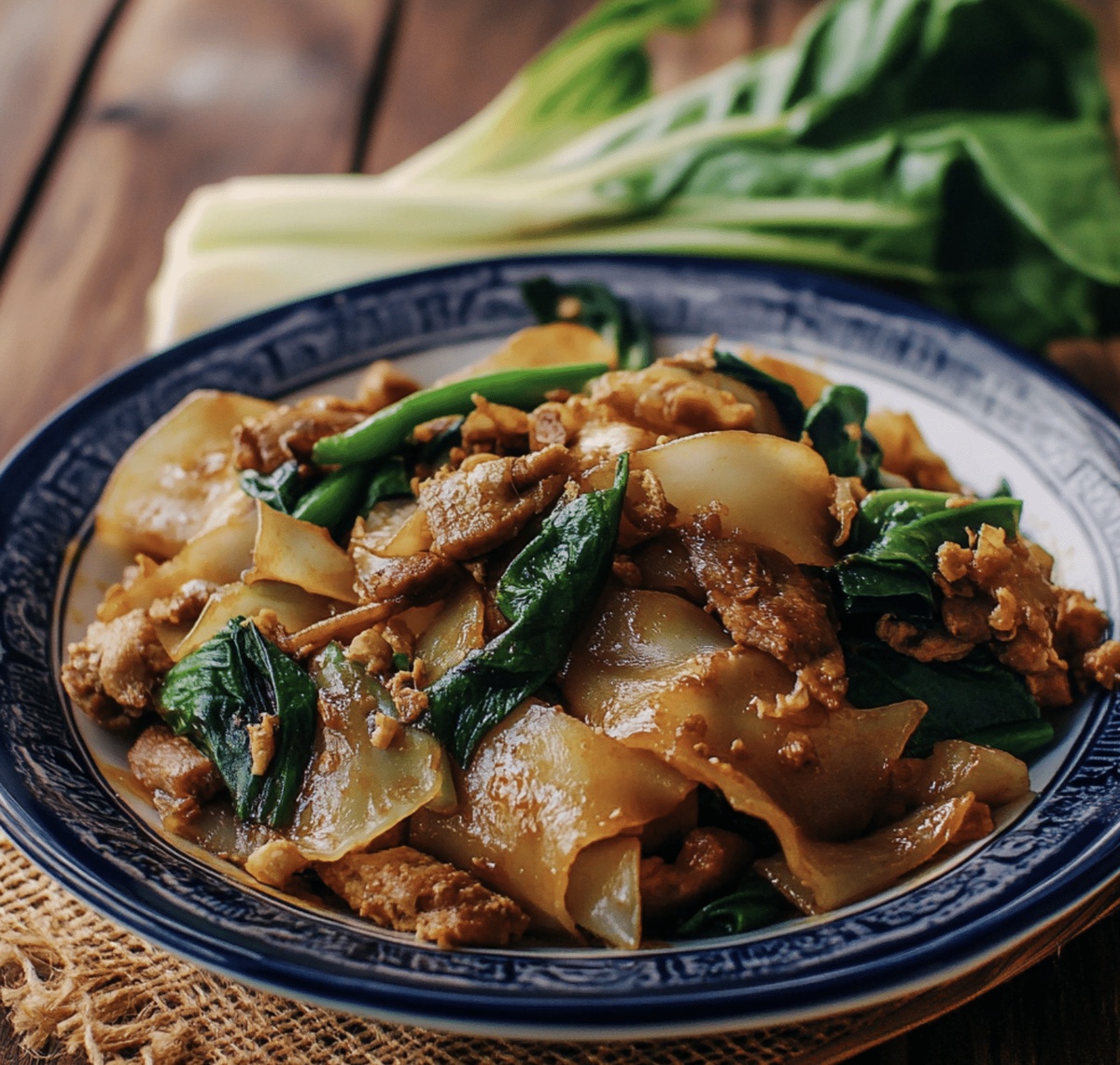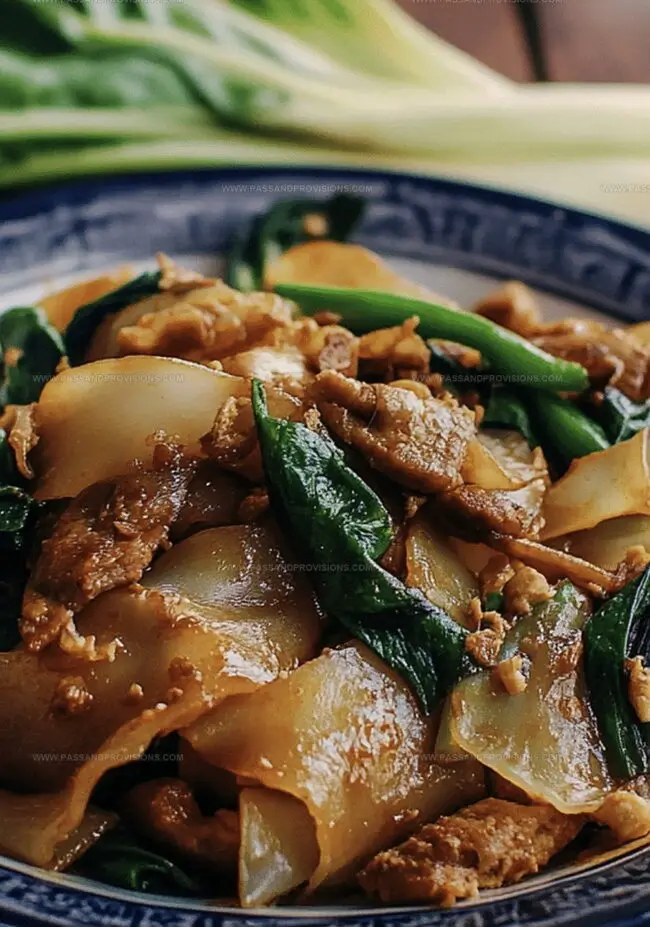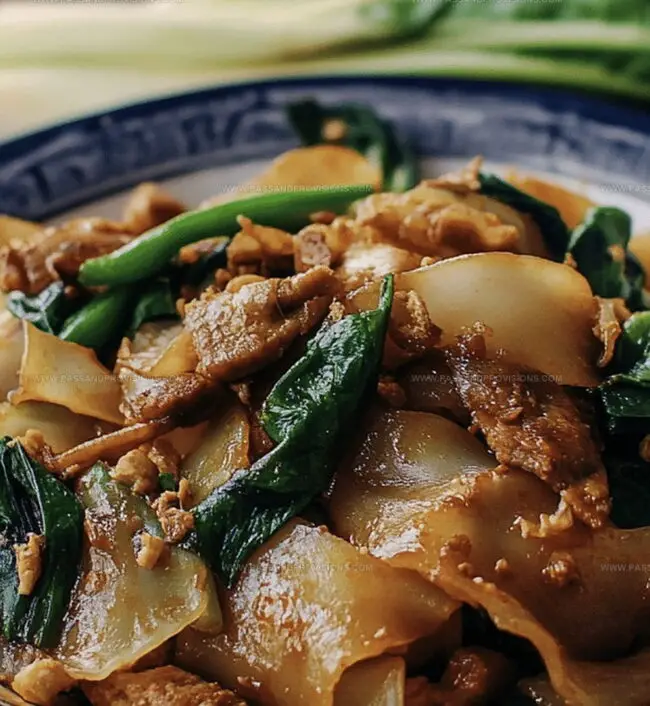Irresistible Pad See Ew (Thai Stir-Fried Noodles) Recipe
Stumbling upon a delectable pad see ew during a bustling Bangkok street market changed my culinary perspective forever.
Noodle enthusiasts crave this iconic Thai dish for its rich, savory flavors.
Silky rice noodles dance with crisp vegetables and tender protein in a wok-kissed symphony.
Chinese broccoli adds a vibrant green crunch that perfectly balances the umami-packed sauce.
Each bite tells a story of tradition and comfort from Southeast Asian kitchens.
Mastering this recipe lets you transport your taste buds straight to the heart of Thailand.
Come explore a dish that promises an authentic culinary adventure waiting to unfold.
Reasons to Love Pad See Ew (Thai Stir-Fried Noodles)
Pad See Ew Ingredients You’ll Need
Noodle Base:Protein Component:Sauce Ingredients:Seasoning Elements:Vegetable Component:Additional Components:Garnish Options:Cooking Instructions for Pad See Ew
Step 1: Noodle Preparation
Gently separate fresh noodles or soak dried noodles in warm water until softened but still slightly firm. Drain thoroughly.
Step 2: Marinate Protein
Coat protein with soy sauce and cornstarch. Let sit for 10-15 minutes to absorb flavors.
Step 3: Create Signature Sauce
Whisk all sauce ingredients in a small bowl until sugar dissolves completely.
Step 4: Sear Protein
Heat wok or large skillet over high heat. Add oil and cook marinated protein until golden and fully cooked. Remove and set aside.
Step 5: Scramble Egg
Add small amount of oil to pan. Crack egg and scramble until just set. Push to side of pan.
Step 6: Aromatic Boost
Add minced garlic. Sauté for 30 seconds until fragrant and slightly golden.
Step 7: Noodle Magic
Introduce noodles to pan. Pour prepared sauce and toss quickly to coat evenly.
Step 8: Green Goodness
Add Chinese broccoli. Stir-fry for 1-2 minutes until leaves slightly wilt.
Step 9: Combine and Finish
Return cooked protein to pan. Stir everything together for additional minute.
Step 10: Serve with Flair
Transfer to serving plate. Garnish with optional:Tips to Perfect Your Thai Stir-Fried Noodles
Storage and Reheat Advice for Pad See Ew
What to Serve with Pad See Ew
Creative Variations for Pad See Ew
Pad See Ew Recipe FAQs
Soak dried noodles in warm water until they’re soft but still slightly firm, and gently separate fresh noodles to prevent sticking and ensure even cooking.
Marinating with soy sauce and cornstarch helps tenderize the meat, adds flavor, and creates a protective coating that keeps the meat juicy during high-heat stir-frying.
Stir quickly and continuously when adding the sauce to the noodles, and maintain high heat to create a quick caramelization without burning the ingredients.
The high-heat wok cooking method allows for quick cooking that seals in flavors, creates slight charring, and ensures each ingredient maintains its texture and taste.
Print
Pad See Ew (Thai Stir-Fried Noodles) Recipe
- Total Time: 25 minutes
- Yield: 2 1x
Description
Comfort meets excitement in this Pad See Ew, a classic Thai noodle dish that dances with savory soy and charred wok flavors. Hearty rice noodles intertwine with tender protein and crisp vegetables, promising a delicious journey through Bangkok’s street food culture you won’t soon forget.
Ingredients
Main Protein:
- 8 ounces (226 grams) chicken, beef, or shrimp, thinly sliced
- 1 egg, lightly beaten
Noodles and Vegetables:
- 8 ounces (226 grams) wide rice noodles (fresh or dried soaked per package instructions)
- 1 cup Chinese broccoli (Gai Lan), cut into 2-inch pieces (or regular broccoli, bok choy, or kale)
- 2 cloves garlic, minced
Sauces and Seasonings:
- 2 tablespoons vegetable oil
- 2 tablespoons dark soy sauce (adds color & depth)
- 1 tablespoon light soy sauce (for saltiness)
- 1 tablespoon oyster sauce (adds richness)
- 1 teaspoon soy sauce
- 1 teaspoon cornstarch (for tender meat, optional)
- 1 teaspoon fish sauce (optional, for umami)
- 1 teaspoon sugar
- ½ teaspoon white vinegar (balances flavors, optional)
- ¼ teaspoon white pepper
Instructions
- Prepare rice noodles by soaking dried varieties in warm water until they reach a pliable yet firm texture, or gently separate fresh noodles to prevent sticking.
- Create a marinade for the protein by combining soy sauce and cornstarch, allowing the mixture to infuse for at least 10 minutes to enhance flavor and tenderness.
- Craft a sauce blend by whisking together dark and light soy sauces, oyster sauce, fish sauce, sugar, vinegar, and white pepper in a separate container.
- Preheat a wok or large skillet over high heat, adding a tablespoon of oil to create an intense cooking surface.
- Sear the marinated protein swiftly, stirring continuously until fully cooked, then transfer to a holding plate.
- Introduce additional oil to the hot pan and quickly scramble the egg until just set, pushing it to the side of the cooking surface.
- Infuse the pan with minced garlic, allowing it to release its aromatic essence for approximately 30 seconds.
- Introduce the prepared noodles to the pan, immediately coating them with the pre-mixed sauce through rapid, continuous stirring.
- Add Chinese broccoli to the mixture, stir-frying for 1-2 minutes until the vegetable begins to wilt slightly.
- Reunite the previously cooked protein with the noodle mixture, stirring thoroughly to integrate all components.
- Plate the dish and offer optional garnishes such as chili flakes, fresh lime wedges, or zesty pickled chili vinegar for personalized heat and brightness.
Notes
- Noodle Softening Secret: Soak dried noodles in warm water until they’re pliable but still have a slight bite, preventing mushy texture during stir-frying.
- Meat Marinade Magic: Let protein sit in soy sauce and cornstarch mixture to enhance tenderness and create a delightful golden crust when cooking.
- Sauce Balance Technique: Combine different sauces carefully to achieve that perfect sweet, salty, and umami flavor profile characteristic of authentic Thai street food.
- High Heat Stir-Fry Pro Tip: Use a blazing hot wok or pan to create signature wok hei flavor and prevent ingredients from becoming soggy or overcooked.
- Vegetarian Swap: Replace meat with firm tofu or tempeh, pressing out excess moisture before marinating to ensure a crispy exterior.
- Gluten-Free Adaptation: Use tamari instead of traditional soy sauce and choose gluten-free rice noodles to make the dish celiac-friendly.
- Spice Level Control: Adjust chili flakes or serve with optional chili vinegar on the side, allowing each diner to customize heat intensity.
- Prep Time: 10 minutes
- Cook Time: 15 minutes
- Category: Lunch, Dinner
- Method: Sautéing
- Cuisine: Thai
Nutrition
- Serving Size: 2
- Calories: 600
- Sugar: 2 g
- Sodium: 900 mg
- Fat: 20 g
- Saturated Fat: 3 g
- Unsaturated Fat: 12 g
- Trans Fat: 0 g
- Carbohydrates: 75 g
- Fiber: 4 g
- Protein: 30 g
- Cholesterol: 150 mg




Jamie Granger
Recipe Developer & Food Writer
Expertise
Education
Culinary Institute of America
Jamie Granger turns ingredients into memories. With her recipes, she brings a fusion-forward flair to every creation.
Her dishes reflect the places she’s explored, the chefs she’s learned from, and the deep connection she has to food as a form of expression.
At Pass and Provision, Jamie develops recipes that balance flavor, health, and beauty, meals that don’t just satisfy your appetite but speak to your curiosity.